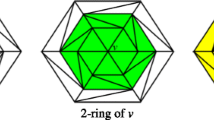Abstract
As a measure of regional importance in agreement with human perception of 3D shape, mesh saliency should be based on local geometric information within a mesh but more than that. Recent research has shown that global consideration has a significant role in mesh saliency. This paper proposes a local-to-global framework for computing mesh saliency where we offer novel solutions to solve three inherent problems: (1) an algorithm based on statistic Laplacian which does not only compute local saliency, but also facilitates the later computation of global saliency; (2) a local-to-global method based on pooling and global distinctness to compute global saliency; (3) a framework to integrate local and global saliency. Experiments demonstrate that our approach can effectively detect salient features consistent with human perceptual interest. We also provide comparisons to existing state-of-the-art methods for mesh saliency and show improved results produced by our method.











Similar content being viewed by others
References
Bylinskii, Z., Judd, T., Borji, A., Itti, L., Durand, F., Oliva, A., Torralba, A.: Mit saliency benchmark. http://saliency.mit.edu/
Castellani, U., Cristani, M., Fantoni, S., Murino, V.: Sparse points matching by combining 3d mesh saliency with statistical descriptors. In: Proceedings of Eurographics, pp. 643–652 (2008)
Chen, X., Saparov, A., Pang, B., Funkhouser, T.: Schelling points on 3D surface meshes. In: Proceedings of SIGGRAPH (2012)
Coifman, R.R., Maggioni, M.: Diffusion wavelets. Appl. Comput. Harmonic Anal. 21(1), 53–94 (2006)
Corbetta, M., Shulman, G.L.: Control of goal-directed and stimulus-driven attention in the brain. Nat. Rev. Neurosci. 3(3), 201–215 (2002)
Dey, T.K., Ranjan, P., Wang, Y.: Convergence, stability, and discrete approximation of laplace spectra. In: Proceedings of ACM-SIAM Symposium on Discrete Algorithms, pp. 650–663 (2010)
Feixas, M., Sbert, M., González, F.: A unified information-theoretic framework for viewpoint selection and mesh saliency. ACM Trans. Appl. Percept. (TAP) 6(1), 1 (2009)
Fu, H., Cohen-Or, D., Dror, G., Sheffer, A.: Upright orientation of man-made objects. In: ACM transactions on graphics (TOG), vol. 27, p. 42. ACM (2008)
Gal, R., Cohen-Or, D.: Salient geometric features for partial shape matching and similarity. ACM Trans. Graph. 25(1), 130–150 (2006)
Guy, G., Medioni, G.: Inference of surfaces, 3d curves, and junctions from sparse, noisy, 3d data. IEEE Trans. Pattern Anal. Mach. Intell. 19(11), 1265–1277 (1997)
Hou, T., Qin, H.: Admissible diffusion wavelets and their applications in space-frequency processing. IEEE Trans. Vis. Comput. Graph. 19(1), 3–15 (2013)
Howard, I.: Seeing in depth. University of Toronto, Toronto (2002)
Itti, L., Koch, C., Niebur, E.: A model of saliency-based visual attention for rapid scene analysis. IEEE Trans. Pattern Anal. Mach. Intell 20(11), 1254–1259 (1998)
Jin, H., Soatto, S., Yezzi, A.: Multi-view stereo reconstruction of dense shape and complex appearance. IJCV 63(3), 175–189 (2005)
Kim, Y., Varshney, A., Jacobs, D., Guimbretiere, F.: Mesh saliency and human eye fixations. ACM Trans. Appl. Percept. 7(2), 12:1–12:13 (2010)
Koch, C., Poggio, T.: Predicting the visual world: silence is golden. Nat. Neurosci. 2, 9–10 (1999)
Koenderink, J.: The structure of images. Biol. Cybern. 50(5), 363–370 (1984)
Lang, C., Nguyen, T.V., Katti, H., Yadati, K., Kankanhalli, M., Yan, S.: Depth matters: Influence of depth cues on visual saliency. In: Proceedings of ECCV, pp. 101–115. Springer (2012)
Lee, C., Varshney, A., Jacobs, D.: Mesh saliency. In: Proceedings of SIGGRAPH (2005)
Lee, S., Xin, J., Westland, S.: Evaluation of image similarity by histogram intersection. Color Res. Appl. 30(4), 265–274 (2005)
Leifman, G., Shtrom, E., Tal, A.: Surface regions of interest for viewpoint selection. In: Proceedings of CVPR (oral) (2012)
Mantiuk, R., Myszkowski, K., Pattanaik, S.: Attention guided mpeg compression for computer animations. In: Spring Conference on Computer graphics, pp. 239–244. ACM (2003)
Matlin, M.W.: Cognition (Textbook), 8th edn. Wiley, New York (2013)
Newman, M.E.: The mathematics of networks. The new palgrave encyclopedia of economics (2008)
Pauly, M., Keiser, R., Gross, M.: Multi-scale feature extraction on point-sampled surfaces. Comput. Graph. Forum 22(3), 281–289 (2003)
Pelphrey, K., Sasson, N., Reznick, J., Paul, G., Goldman, B., Piven, J.: Visual scanning of faces in autism. J. Autism Dev. Disord. 32(4), 249–261 (2002)
Perron, O.: Zur theorie der matrices. Mathematische Annalen 64(2), 248–263 (1907)
Secord, A., Lu, J., Finkelstein, A., Singh, M., Nealen, A.: Perceptual models of viewpoint preference. ACM Trans. Graph. (TOG) 30(5), 109 (2011)
Shilane, P., Funkhouser, T.: Distinctive regions of 3d surfaces. ACM Trans. Graph. 26(2), 7 (2007)
Song, R., Liu, Y., Martin, R.R., Rosin, P.L.: Mesh saliency via spectral processing. ACM Trans. Graph. 33(1), 6 (2014)
Sun, J., Ovsjanikov, M., Guibas, L.: A concise and provably informative multi-scale signature based on heat diffusion. In: Proceedings of SGP, pp. 1383–1392 (2009)
Tao, P., Cao, J., Li, S., Liu, X., Liu, L.: Mesh saliency via ranking unsalient patches in a descriptor space. Comput. Graph. 46, 264–274 (2015)
Taubin, G.: A signal processing approach to fair surface design. In: Proceedings of SIGGRAPH, pp. 351–358. ACM (1995)
Wolfe, J.M.: Guided search 2.0 a revised model of visual search. Psychon. Bull. Rev. 1(2), 202–238 (1994)
Wu, J., Shen, X., Zhu, W., Liu, L.: Mesh saliency with global rarity. Graph. Models. 75(5), 255–264 (2013)
Yee, H., Pattanaik, S., Greenberg, D.: Spatiotemporal sensitivity and visual attention for efficient rendering of dynamic environments. ACM Trans. Graph. 20(1), 39–65 (2001)
Acknowledgements
This work is partly funded by EPSRC via the ‘Automatic Semantic Analysis of 3D Content in Digital Repositories’ project (EP/L006685/1). This support is gratefully acknowledged.
Author information
Authors and Affiliations
Corresponding author
Rights and permissions
About this article
Cite this article
Song, R., Liu, Y., Martin, R.R. et al. Local-to-global mesh saliency. Vis Comput 34, 323–336 (2018). https://doi.org/10.1007/s00371-016-1334-9
Published:
Issue Date:
DOI: https://doi.org/10.1007/s00371-016-1334-9




